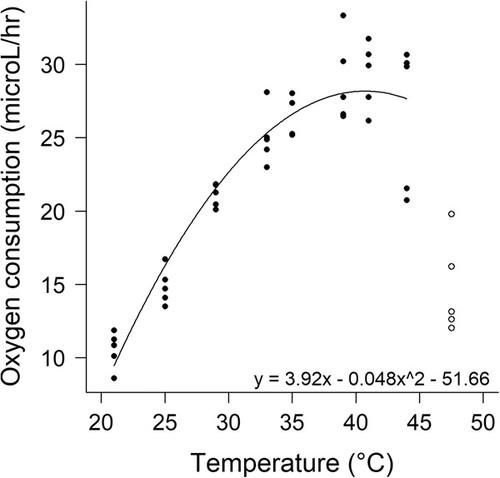当前位置:
X-MOL 学术
›
J. Exp. Zool. Part A
›
论文详情
Our official English website, www.x-mol.net, welcomes your feedback! (Note: you will need to create a separate account there.)
Thermal sensitivity of lizard embryos indicates a mismatch between oxygen supply and demand at near‐lethal temperatures
Journal of Experimental Zoology Part A ( IF 2.8 ) Pub Date : 2020-04-16 , DOI: 10.1002/jez.2359 Joshua M Hall 1 , Daniel A Warner 1
Journal of Experimental Zoology Part A ( IF 2.8 ) Pub Date : 2020-04-16 , DOI: 10.1002/jez.2359 Joshua M Hall 1 , Daniel A Warner 1
Affiliation

|
Aspects of global change create stressful thermal environments that threaten biodiversity. Oviparous, non‐avian reptiles have received considerable attention because eggs are left to develop under prevailing conditions, leaving developing embryos vulnerable to increases in temperature. Though many studies assess embryo responses to long‐term (i.e., chronic), constant incubation temperatures, few assess responses to acute exposures which are more relevant for many species. We subjected brown anole (Anolis sagrei) eggs to heat shocks, thermal ramps, and extreme diurnal fluctuations to determine the lethal temperature of embryos, measure the thermal sensitivity of embryo heart rate and metabolism, and quantify the effects of sublethal but stressful temperatures on development and hatchling phenotypes and survival. Most embryos died at heat shocks of 45°C or 46°C, which is ~12°C warmer than the highest constant temperatures suitable for successful development. Heart rate and O2 consumption increased with temperature; however, as embryos approached the lethal temperature, heart rate and CO2 production continued rising while O2 consumption plateaued. These data indicate a mismatch between oxygen supply and demand at high temperatures. Exposure to extreme, diurnal fluctuations depressed embryo developmental rates and heart rates, and resulted in hatchlings with smaller body size, reduced growth rates, and lower survival in the laboratory. Thus, even brief exposure to extreme temperatures can have important effects on embryo development, and our study highlights the role of both immediate and cumulative effects of high temperatures on egg survival. Such effects must be considered to predict how populations will respond to global change.
中文翻译:

蜥蜴胚胎的热敏性表明在接近致命温度下氧气供需之间不匹配
全球变化的各个方面创造了威胁生物多样性的压力性热环境。卵类,非禽类爬行动物已受到相当多的关注,因为卵在当前条件下发育,而发育中的胚胎易受温度升高的影响。尽管许多研究评估了胚胎对长期(即慢性)恒定孵化温度的反应,但很少评估与多种物种相关的急性暴露的反应。我们吃了棕色的Anole(Anolis sagrei鸡蛋受热冲击,温度上升和极端的昼夜波动影响,以确定胚胎的致死温度,测量胚胎心率和新陈代谢的热敏感性,并量化亚致死压力对发育,孵化表型和存活的影响。大多数胚胎在45°C或46°C的热冲击下死亡,这比适合成功发育的最高恒定温度高约12°C。心率和O 2消耗量随温度升高而增加。但是,随着胚胎接近致死温度,心率和CO 2产量持续上升,而O 2消费平稳。这些数据表明高温下氧气供需之间不匹配。暴露于极端的,昼夜的波动会降低胚胎的发育速度和心率,并导致孵化出的幼虫体型较小,生长速度降低和实验室存活率降低。因此,即使短暂暴露于极端温度下也会对胚胎发育产生重要影响,我们的研究强调了高温对鸡蛋存活的即时和累积影响。必须考虑这些影响,以预测人口将如何应对全球变化。
更新日期:2020-04-16
中文翻译:

蜥蜴胚胎的热敏性表明在接近致命温度下氧气供需之间不匹配
全球变化的各个方面创造了威胁生物多样性的压力性热环境。卵类,非禽类爬行动物已受到相当多的关注,因为卵在当前条件下发育,而发育中的胚胎易受温度升高的影响。尽管许多研究评估了胚胎对长期(即慢性)恒定孵化温度的反应,但很少评估与多种物种相关的急性暴露的反应。我们吃了棕色的Anole(Anolis sagrei鸡蛋受热冲击,温度上升和极端的昼夜波动影响,以确定胚胎的致死温度,测量胚胎心率和新陈代谢的热敏感性,并量化亚致死压力对发育,孵化表型和存活的影响。大多数胚胎在45°C或46°C的热冲击下死亡,这比适合成功发育的最高恒定温度高约12°C。心率和O 2消耗量随温度升高而增加。但是,随着胚胎接近致死温度,心率和CO 2产量持续上升,而O 2消费平稳。这些数据表明高温下氧气供需之间不匹配。暴露于极端的,昼夜的波动会降低胚胎的发育速度和心率,并导致孵化出的幼虫体型较小,生长速度降低和实验室存活率降低。因此,即使短暂暴露于极端温度下也会对胚胎发育产生重要影响,我们的研究强调了高温对鸡蛋存活的即时和累积影响。必须考虑这些影响,以预测人口将如何应对全球变化。



























 京公网安备 11010802027423号
京公网安备 11010802027423号